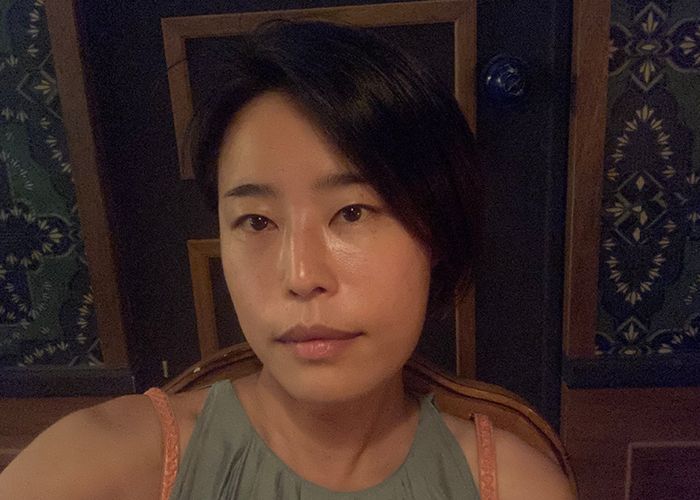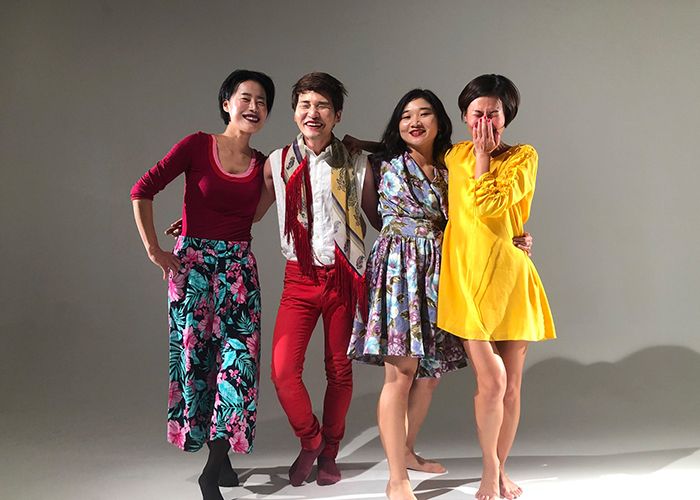From Los Angeles to Korea: How Three Alumnx Began Their Careers after Otis
Otis alumnx share their experiences returning home after studying abroad in Los Angeles.

Otis College has long celebrated the diversity of its students, many of whom come to its Westchester campus from all corners of the globe—this academic year we welcomed students from China, Sweden, and Vietnam, among many other countries. After graduation, several alumnx remain in Los Angeles to live and work, however many of our international students return home to embark on their art and design careers. We connected with three Otis College alumnx living and working in Korea, who shared why they chose Otis, how the College prepared them for life after graduation, and how Otis can better serve its diverse network of alumnx around the world.

David Kim (’20 BFA Digital Media)
Motion Graphics Artist, Activision Blizzard
When did you first decide that you wanted to pursue a career in art and design?
I knew it when I took a digital media course at Korea International School. I created various motion graphics videos for our school and loved the reactions.
What attracted you to Otis College?
Otis College was the only college that had a solid motion graphics course. I absolutely fell in love with the reels the previous students and alumni had, which is what ultimately made me want to go to Otis
Are there particular courses or faculty that you feel were instrumental in your success today?
Justin Harder’s motion graphics classes definitely made me succeed. His course was intense and also an eye-opener for me. I also loved Dawn Yamazi’s business seminar course. She taught me what it means to do business as an artist.
What were some of the highlights of your time in Los Angeles?
My highlights of L.A. would be the time I had my first job, which was working as an intern at Brand New School. Working there made me learn how to work as a motion designer/animator and make many connections with other motion graphics artists. I had the most fun there and experienced working with big brands such as Google, Snapchat, and Starbucks.
What were your first years after Otis College like?
My first year after Otis College was quite busy in terms of working. I actually flew back to Korea the moment Otis went fully online [due to the COVID-19 pandemic], which was around March 2020. I then immediately got a job at a Korean advertising agency for fashion brands. My transition into the working world from college was quite smooth. I did have an internship in my junior year summer, which I got during Otis’s internship fair, and because of that experience, working out of college was quite easy. Getting used to nine-to-five hours and working with other team members was already something I’d learned by then.
Going back to Korea after studying and working in the United States is a huge eye-opener. I realized that in Korea most employers treat study abroad students with degrees outside of Korea to be more educated and of higher value. Work ethic is also quite different. Many companies do not allow junior and senior artists to give their input into the work we are tasked with. It is most common to just make the work the director asks you for, whereas U.S. companies mostly ask you to give your feedback and critique the artwork.
Do you keep in contact with other Otis alumnx in Korea? How can Otis help create a sense of community among its alumnx overseas?
I keep in contact with other Otis students and alumni through my art Instagram and Discord accounts. There is no official way of connecting with alumni overseas, but Otis can create some events at school and maybe in Korea before or after graduation, inviting every international student and alumni to come together for a hangout. This can allow students and alumni to get more connected and increase the number of connections made to keep a sense of community for Otis alumni overseas.
What can you share about your experiences as a Korean international student that will help others who are considering attending Otis, or are already students here?
I do hold U.S. citizenship with a permanent residence in Korea, but if I were to give my input on other international students, I’d say that Otis is a good college for the motion design program. There are many connections here for motion students to succeed and get work when they graduate. It is tough, however, if you are a Korean citizen, because you cannot skip the mandatory military requirement, and getting a job as a foreigner can be difficult in the U.S.
In what ways do you think Otis College can further support Korean students and alumnx?
Otis can help create small environments in Korea for students to gather together again once in a while to have community. I believe the motion graphic industry in Korea is still growing and the demand is huge. If Otis international alumni were able to meet up after graduation, this can allow more alumni to recommend each other to companies within Korea and help each other get jobs.
“If the studio courses taught me what to design, Liberal Arts and Sciences courses helped me understand and convince others why I design.”
Joong Han Lee (’09 BFA Product Design)
Senior Product Designer, Note Design Studio (Stockholm, Sweden); formerly co-founder of TIEL (Seoul, Geneva)
When did you first decide that you wanted to pursue a career in art and design?
Since childhood I have always enjoyed drawing and making things. But I clearly remember the moment I knew I wanted to pursue a career in design was when I saw an S-shaped plastic chair created by the Danish designer Verner Panton in the 60s. I still consider this world’s first molded plastic chair as the epitome of form and function, in perfect harmony.
What attracted you to Otis College?
One of my Korean-American family friends from greater Los Angeles told me about Otis. As an international student, I knew living close to relatives and friends could always help me mentally and emotionally whenever needed, so I decided to stay in the West Coast.
Are there particular courses or faculty that you feel were instrumental in your success today?
There are so many to choose from, but I must admit that the Liberal Arts and Sciences curriculum throughout the years really helped me to become critical and elaborate in my design process. If the studio courses taught me what to design, LAS courses helped me understand and convince others why I design.
What were some of the highlights of your time in Los Angeles?
The Venice Beach Boardwalk, Santa Monica Pier, Dodger Stadium, surfing with the sunrise, wine tasting in Culver City, getting my first tattoo, pub crawling with friends. I have had the privilege of living in five different countries so far, but I still tell people that in L.A. I had the best experience by far.
What were your first years after Otis College like?
My professional career didn’t start right away, as I decided to study design further. At Otis we once had a special guest lecture by a Dutch duo Tejo Remy and René Veenhuizen, who I was struck by their conceptual approach in design. This very unique opportunity encouraged me to pack my suitcase for Europe. As an extension of study, I was able to discourse constructively with lecturers and to justify concepts behind my design.
In what ways can Otis improve how it helps its international students with the transition back home, and with finding jobs?
As an active professional, having a strong portfolio with collaborations with international companies could really help students set themselves apart from the others.
What can you share about your experiences as a Korean international student that will help others who are considering attending Otis, or are already students here?
Go out and experience! Studying is important, but I learned much later that having a great network is more important and can lead to many different opportunities, mostly unexpected.
In what ways do you think Otis College can further support Korean students and alumnx?
I see alumni internship programs with active students that can be supported by schools here in Korea. That could be a nice way to grow together.

Boseul Kim (’10 MFA Public Practice)
Official at Islands Culture Diversity Network (www.islands-network.or.kr), Independent Art Producer, and Geography Researcher
When did you first decide that you wanted to pursue a career in art and design?
It was during my undergrad years. My major in Seoul was interior architecture, but soon I realized that I was more fond of texts. I thought about how I could combine these two areas—my major and my enthusiasm—and I began to have a notion that I should apply my architectural design education to either theatrical design, i.e. lighting or set design, or graphic communication, i.e. print matter design. But my interests were not reduced to those alleys, they rather made me keep wondering and exploring other options, such as public design, and I started wanting to expand my circle and study abroad.
What attracted you to Otis College?
Otis was the only school that had a major, Public Practice, that I had not heard of earlier. I only imagined that it was something close to a public design discipline, such as urban furnishing strategies. Los Angeles definitely was not an ideal place I would fancy to move. Except for the size of the city, I strongly doubted what “artistic” value it might have. Later, I began to notice there were other values for art and design practices.
Are there particular courses or faculty that you feel were instrumental in your success today?
I could name quite a few! Suzanne Lacy, who was the chair of my program at that time, who at first I was not sure if I wanted to be a student of, but soon her presence in life and art became a great inspiration for me, her heart in itself was a teacher. Finally it was Suzanne who brought me back to Korea to work together in the Anyang Public Art Project 2010 (APAP2010). Patricia Kovic and her Neighbor Gap Bridge course—for whom I TA’ed—we worked together in the course even after I graduated, in total for three years. Marlena Donohue, who gripped on me to help me write my thesis and see artistic/philosophical concepts better in English. Claude Willey was an amazing lecturer and music lover who always invited us to new ways of navigating a city as a canvas. There are many others!

Image of Kim with artist colleagues in Korea, courtesy of Boseul Kim (’10 MFA Public Practice).
What were your first years after Otis College like?
I was very lucky to have a teacher like Suzanne Lacy, who has a wide, high-level international network with which she could engage international students like me. In 2010, the year I graduated, Suzanne was one of the invited artists in APAP2010 and I was hired as a research assistant for her. While working with her in Korea and in Bristol, England, I was not only introduced to important art professionals in Korea and other countries, but also trained to globally work between remote places, using the Korean and English languages, academic knowledge, and skill sets. Completing APAP2010 in 2011, I returned to Los Angeles and co-taught a Graduate-level case study course at Otis with her for a semester. The experience with my admired teacher in APAP2010 in my country had a great impact on me. Even after the project, the people I met there became a sustainable network for me. Even today!
In what ways do you think Otis College can further support Korean students and alumnx?
I am occasionally in touch with a couple of Otis alumni in Korea. I hope there are special activities to meet each other and even more people. But something only exclusively open for Otis alumni would be less attractive. I would like to expand our network with others who would understand what it means to graduate from Otis. This is crucial! If Otis establishes partnerships with one or two other institutions to which many Korean students enroll, I guess Otis alumni would pay more attention to ourselves and exchange information across more diverse groups. I hope to meet the returning alumni in Korea, not only from Otis, but also from other schools like Parsons, Pratt, Art Center, SAIC [School of the Art Institute of Chicago], CalArts, Yale, Carnegie Mellon, etc. But even one or two of them will be enough.
Are you an Otis alumni living and working overseas? We want to hear from you! Email us at communications@otis.edu and let us know how you’re doing!

